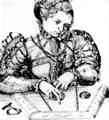
fig. 49: from Tobias Stimmer
(1539-1584),
'Women
musicians'
fig. 53:
'box' and 'integral' constructions
- sections
CHAPTER 3: History to 1800
3.5 The Baroque, Rococo and Classical Periods 1600-1800
3.5.1 The west
1.1. Popular cultures in the 17th & 18th centuries:
2. Germania
Detailed evidence: 6 of 6: Summary
[p.123]
From an examination of the evidence we can build up a picture of a typical popular dulcimer of the 17th and 18th centuries, as played in the Germanic lands: it was almost invariably trapezoid and nearly always had two long unbroken bridges, one treble and one bass - one example has no bass bridge, and one has its treble bridge broken into two parts to enable extra semitones to be obtained. It usually had four strings to a course, but quite often five, and sometimes three; occasionally the bass courses had one fewer note per course than the treble courses, but this was not very common (one instrument and Praetorius' illustration). The number of courses varied considerably; there might be 10-15, 19-21 or 24-26, usually divided equally between treble and bass, but there are examples with extra bass strings. The wrest-pins were normally made from flattened nails, a notch being filed in the top to catch the end of the wire just as drawn by Hutmacher in 1590, fig. 58; they were usually mounted in the top of the instrument.
|
|
|
|
|
|
fig. 53:
'box' and 'integral' constructions |
The former style has continued in use up to the present, however, and to consider them to be 'younger' and 'older' forms, as Norlind was apparently intending to (96) does not really reflect the true position.
One innovation which does appear in this era, however, is that of ditals, the little metal levers placed near the ends of some of the strings so that, when brought into play, they raise the pitch of that course by a semitone; they are used particularly for altering a leading-note (e.g. changing a B♭ in the key of F to a B♮ for the key of C), hence one German name for them, Leittonhebeln 'leading-note levers'. Their use was nevertheless rare during this period. Dr. van der Meer also mentions double-sided instruments in Germany and the Netherlands (159), although the example he mentions, Berlin 2146, was apparently destroyed in the last war (160).
There is very little information about the playing positions used, but at least one instrument has a neck-strap, also shown in one illustration and implied in another; otherwise the player's lap or table seems to have been used.
Many instruments were decorated, usually fairly simply, but a carved wooden soundhole, or perhaps two, were common; some examples had more elaborate rose-painting on the edges, and one even has a metal rose, apparently a simplified imitation of an upper-class salterio.
|
|